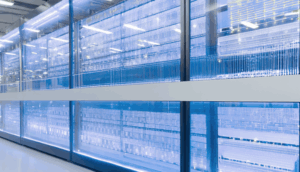CC-Link IE (Industrial Ethernet) stands as a prominent force in the realm of industrial automation, offering a high-speed, deterministic communication network tailored for demanding manufacturing environments. Its ability to transmit large volumes of data in real-time makes it ideal for applications ranging from motion control and robotics to process monitoring and quality inspection. As we approach 2025, advancements in CC-Link IE technology promise to further revolutionize industrial communication, unlocking new levels of efficiency, productivity, and flexibility.
One key area of advancement lies in the ongoing development of faster data transmission rates. While existing CC-Link IE networks already boast impressive speeds, research and development efforts are focused on pushing the boundaries even further. Increased bandwidth will enable more complex and data-intensive applications, such as advanced predictive maintenance systems that rely on real-time analysis of sensor data from across the plant floor. Furthermore, enhanced network performance will facilitate the integration of more devices and systems, creating a truly connected and intelligent manufacturing ecosystem. Another area of focus involves enhancing the robustness and reliability of CC-Link IE networks. Industrial environments are notoriously harsh, with factors like electromagnetic interference (EMI), vibration, and temperature fluctuations posing significant challenges to communication infrastructure. Future iterations of CC-Link IE are expected to incorporate more sophisticated shielding techniques, error correction mechanisms, and redundancy protocols to ensure uninterrupted operation even under extreme conditions.
Beyond raw performance improvements, significant strides are being made in the development of more user-friendly and flexible CC-Link IE solutions. Configuration and maintenance of industrial networks can be complex and time-consuming, often requiring specialized expertise. Emerging tools and technologies are aimed at simplifying these processes, allowing manufacturers to deploy and manage CC-Link IE networks with greater ease and efficiency. This includes intuitive software interfaces, automated diagnostics, and remote management capabilities. The push towards greater interoperability is also a crucial aspect of future CC-Link IE development. As manufacturers increasingly rely on heterogeneous systems from different vendors, the ability to seamlessly integrate these systems into a unified communication network becomes paramount. Efforts are underway to promote greater standardization and compliance, ensuring that CC-Link IE networks can interoperate effectively with a wide range of industrial devices and platforms.

The integration of wireless technologies into CC-Link IE networks is another promising area of innovation. While wired connections offer superior reliability and bandwidth in many industrial applications, wireless communication provides greater flexibility and mobility, enabling new use cases such as remote monitoring, mobile robotics, and asset tracking. Hybrid solutions that combine the strengths of both wired and wireless technologies are expected to become increasingly prevalent in the coming years. For example, wireless sensors can be deployed in hard-to-reach locations to collect data, which is then transmitted back to a central control system via a wired CC-Link IE backbone. These future breakthroughs hinge on the development of robust industrial data communication cables, capable of supporting the advanced technologies being created for the industrial sector.

In conclusion, CC-Link IE is poised to play an even more critical role in the future of industrial automation. Driven by advancements in data transmission rates, robustness, usability, interoperability, and wireless integration, the technology promises to unlock new levels of efficiency, productivity, and flexibility for manufacturers worldwide. As we look towards 2025 and beyond, CC-Link IE will undoubtedly remain at the forefront of industrial communication, empowering businesses to thrive in an increasingly competitive and data-driven global economy. The ongoing development of high-quality, robust industrial data communication cables will be a crucial enabler for these advancements.